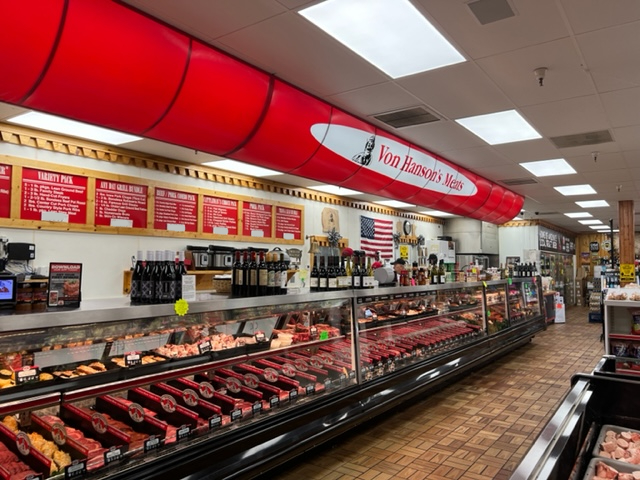Discover the Art of the Butcher's Cut in a Modern Meat Market
In the ever-evolving landscape of modern meat markets, the butcher's cut has transcended its typical roots, merging olden craftsmanship with modern practices. What absolutely sets the modern-day butcher apart is their capability to forge a much deeper link between consumers and the origins of their meat.
Advancement of Butchery Techniques
The development of butchery techniques shows a rich tapestry of advancement and adaptation driven by improvements in technology, modifications in consumer demand, and a much deeper understanding of meat science. Historically, butchery was a craft passed down via generations, with methods sharpened over centuries to optimize yield and flavor. Nonetheless, the industrial transformation introduced mechanization, transforming standard practices and allowing large handling.
The mid-20th century saw butchery methods better refined by scientific insights into muscular tissue biology and meat aging, boosting both tenderness and taste. Developments like vacuum cleaner product packaging and refrigeration expanded item shelf-life, allowing butchers to diversify offerings and improve quality assurance. This duration additionally noted the surge of customized equipment, such as band saws and meat slicers, which increased precision and effectiveness in meat processing.

The 21st century has introduced digital technology into the butchery world. Digital systems currently assist in monitoring animal provenance and enhancing cuts to meet specific customer choices. In addition, a rebirth in artisanal butchery has actually arised, blending traditional skills with modern-day expertise to deal with customers looking for honest and sustainable meat options. This advancement emphasizes a dynamic interplay in between custom and development, meeting modern needs while preserving the craft's heritage.
Recognizing Meat Cuts
Comprehending the intricacies of meat cuts is necessary for both butchers and customers seeking high quality and worth. For butchers, precise cuts show ability and respect for the craft, guaranteeing marginal waste and optimum yield.

Comprehending muscle composition is critical; muscle mass utilized more regularly by the pet tend to be harder and are best fit for slow food preparation techniques, while less-used muscles, like those located in the loin, are a lot more tender and ideal for cooking or roasting. Experience with these distinctions encourages consumers to make enlightened options, enhancing their cooking endeavors.
Picking High Quality Meat
Choosing the ideal meat involves greater than just selecting a visually enticing piece from find here the display screen. bagley farms meat market edwardsville il. The art of selecting top quality meat needs a critical eye and understanding of details characteristics that indicate freshness and quality. Pay focus to the color; beef ought to have an intense, cherry-red hue, while lamb must show a soft pink tone, and pork a pale pink. This suggests the meat is fresh and hasn't been revealed to oxygen for as well lengthy.
Secondly, think about the marbling, which refers to the white streaks of fat within the muscular tissue. Correct marbling is a key indicator of tenderness and flavor, as it melts during cooking, improving the meat's juiciness. Keep in mind, greater marbling usually associates with premium quality cuts, such as USDA Prime.
Texture is another crucial element; meat ought to feel solid to the touch, not slimy or excessively soft. Furthermore, bear in mind the fragrance. Fresh meat ought to have a clean, neutral smell, without any sour or off-putting smells.
Coupling Cuts With Food Preparation Approaches

On the other hand, harder cuts like brisket and chuck roast are abundant in collagen, which damages down into gelatin when cooked gradually. These cuts are excellent for braising or slow roasting, allowing the meat to tenderize gradually and create deep, complex flavors. Similarly, cuts such as short ribs and pork shoulder get on well with slow-cooking approaches, where expanded cooking times change their durable appearances into succulent dishes.
Lamb shanks and oxtail, which need extended food preparation to tenderize, are perfect candidates for stewing or slow simmering. These methods coax out rich, passionate tastes while keeping dampness. By recognizing the one-of-a-kind features of each cut, cooks and home chefs alike can raise their culinary creations, making sure each meal is both satisfying and memorable.
The Butcher's Function Today
Navigating the progressing landscape of the contemporary meat market, the butcher's function today expands beyond plain prep work of cuts. Contemporary butchers are culinary craftsmens, educators, and supporters for sustainable techniques. They connect the gap in between the farm and the fork by making certain honest sourcing, recognizing animal husbandry, and focusing on transparency in the supply chain. This change shows the expanding consumer need for quality over amount, where provenance and animal well-being are paramount.
In addition to crafting exact cuts, butchers now engage straight with customers, providing cooking suggestions and tailoring choices to match individual requirements and choices. Their competence in meat aging, marbling, and taste profiles equips customers to make Web Site enlightened decisions, improving their cooking experiences. This personalized service exhibits the butcher's advancing role as a trusted consultant in the cooking area.
Moreover, butchers are critical in lessening waste, making use of entire animals to create diverse products such as sausages and supplies. This thorough approach not only appreciates the pet yet additionally aligns with contemporary sustainability goals. This way, the modern-day butcher personifies both tradition and development, adapting to an ever-changing market while protecting the creativity and honesty of their craft.
Verdict
Proficiency in comprehending diverse meat cuts and quality indications equips butchers to provide enlightened recommendations, straightening certain cuts with optimal food preparation approaches. By honoring historical techniques while accepting contemporary needs, the butcher's function remains essential in today's advanced meat market.